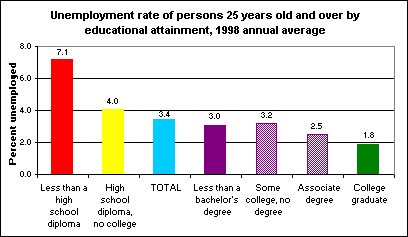An official website of the United States government
 United States Department of Labor
United States Department of Labor
The unemployment rate for those with a college degree was 1.8 percent in 1998. As educational levels decreased, unemployment rates increased—to about 3.0 percent for those with less than a bachelor’s degree (some college or associate degree), 4.0 percent for those with high school diplomas, and 7.1 percent for those who did not finish high school.

[Chart data—TXT]
For each gender (men/women) and race or ethnic group (white/black/Hispanic) breakout, the unemployment rates for people with some college (but no degree), an associate’s degree, or a bachelor’s degree were lower than the overall unemployment rate for the group. The unemployment rates for those people with a high school diploma or less were higher than the overall unemployment rates with one exception—Hispanic high school graduates had the same unemployment rate as all Hispanics.
These data on employment status by educational attainment are produced by the Current Population Survey. More information can be found in More information can be found in Table 7 of the January 1999 edition of "Employment and Earnings." The data in this article are 1998 annual averages.
Bureau of Labor Statistics, U.S. Department of Labor, The Economics Daily, Unemployment rate drops with additional education at https://www.bls.gov/opub/ted/1999/mar/wk2/art04.htm (visited December 15, 2025).

